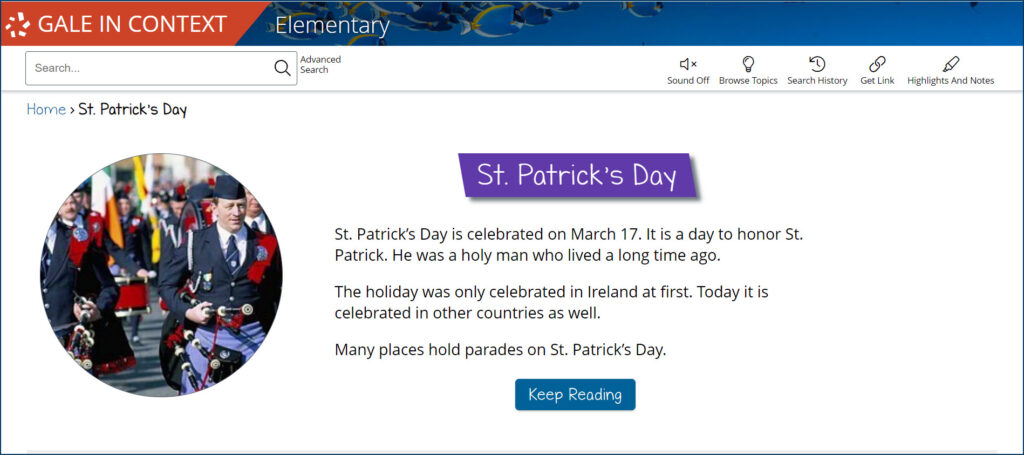| By Gale Staff |
Whether sharing a meal of corned beef and cabbage, watching a parade through the city, or simply sporting a green outfit, there are many fun and fascinating ways to observe St. Patrick’s Day. While not a federally recognized holiday, more than half of Americans partake in the celebration, regardless of their Irish heritage—or lack thereof. Many schools also choose to share in the holiday festivities, and educators often feature crafts and stories that highlight these special Irish traditions.
St. Patrick’s Day is always on March 17, which happens to be a Sunday in 2024. As such, elementary teachers may instead plan their St. Patrick’s Day lesson plans for the Friday before. To get started, lean on the resources available through Gale. Gale In Context: Elementary features a St. Patrick’s Day portal, designed and vetted for beginning learners. Plus, Gale In Context: For Educators provides busy teachers with specialized tools and tips to maximize your classroom impact while minimizing prep time. Think of Gale as your “lucky charm” for St. Patrick’s Day—and many other holidays!

Ireland is roughly the same size as South Carolina and has just 7 million people, yet 63% of Americans observe the St. Patrick’s Day holiday. Modern St. Patrick’s Day parties tend to feature festive leprechaun hats and pints of green beer. Like many holidays, the Western world has heavily commercialized St. Patrick’s Day, but the March 17 celebration has significant historical roots. However, few of your young students may know the real story. St. Patrick’s Day commemorates Irish culture, but who exactly was St. Patrick? Why do we wear green? And what exactly is a leprechaun?
To answer these questions, guide your students to Gale In Context: Elementary. Our team curates information for elementary learners, helping them develop their beginning research skills and find content that meets their specific academic needs. Begin with the St. Patrick’s Day summary page, which explores some of the holiday’s history, symbols, and traditions. Students can even toggle between reading levels and opt for an audio format to help them surpass learning barriers and find the answers they need.
Discover the History of St. Patrick
St. Patrick is the patron saint of Ireland. Patrick was technically British, not Irish, as he was born in Great Britain in the early fourth century. The Roman Empire’s impending withdrawal from Britain destabilized the region and Irish raiders invaded Great Britain, kidnapping British citizens as enslaved people. Patrick was a captive in Ireland for several years; isolated and fearful, he turned to religion for comfort.
After escaping his confinement, Patrick spent his adulthood training as a priest and eventually returned to Ireland as a Christian missionary. Familiar with Irish traditions and language, he was extremely successful and found creative ways to integrate his religious teachings with the existing pagan culture. He died on March 17, 461, which the church officially recognized as St. Patrick’s Day in the seventeenth century. [Opportunity to add a paragraph about the holiday’s early observances/how it’s evolved over the years?
Activity Idea: The United Kingdom and Ireland are two entirely different sovereign nations, each rich with complex cultures, languages, and traditions. Your elementary learners may need help understanding the difference, so introduce a regional map worksheet. Using geographic resources in Gale In Context: Elementary, have students identify Wales, Scotland, England, Northern Ireland, and the Republic of Ireland. Students can label and color the map accordingly.
Share St. Patrick’s Day Traditions
While St. Patrick’s Day may have started as a religious observance, the holiday has since evolved and established all kinds of unique customs. In places like Boston, Chicago, New York, and Philadelphia, hundreds of thousands attend their city’s annual St. Patrick’s Day parade. People hang decorations and make Irish treats. In the U.S., corned beef and cabbage is an iconic St. Patrick’s Day meal. Irish musicians may perform concerts, and some people even light fireworks.
In Ireland, many families attend a special St. Patrick’s Day service in the morning before engaging in festivities later in the day. People throughout the country enjoy traditional Irish dancing and music. However, the holiday is somewhat more low-key in many Irish communities than in large American cities. It’s a chance for the family to join together, enjoy a meal (in Ireland, this typically includes bacon and cabbage or lamb), and simply appreciate their shared cultural heritage.
Discussion Idea: Encourage young students to share whether they celebrate St. Patrick’s Day at home. How does their family celebrate the holiday? For those students who do not observe St. Patrick’s Day, ask them to consider if any of their own family customs are similar to those of Irish families. Connecting with other cultures, regardless of religion, is vital for young people to develop their curiosity and empathy.
Investigate St. Patrick’s Day Legends
Every culture has its unique legends, and St. Patrick’s Day is a fun way to recognize certain Irish myths and mysteries. Few creatures of folklore are more famous than the leprechaun. Known for their tiny size, mysterious treasure, and trickster nature, leprechauns are synonymous with Irish culture in the minds of many Americans and feature prominently in St. Patrick’s Day celebrations. In fact, the tradition of wearing green on St. Patrick’s Day even stems from the leprechaun myth; the mischievous fairies are said to pinch anyone who fails to wear their favorite emerald hue on the holiday.
Another important St. Patrick’s Day symbol is the shamrock (not to be confused with the four-leaf clover, though both are used in St. Patrick’s iconography). Legend suggests that St. Patrick used the three-leaf shamrock to illustrate the Christian Holy Trinity: the Father, the Son, and the Holy Spirit. Stemming from that belief, Irish people would wear shamrocks to St. Patrick’s Day church services as the little green clover grew abundantly throughout the country.
Storytelling and mythology are essential to Irish culture. In addition to leprechauns and shamrocks, there are many more folk traditions to discover, such as banshees and fairies. These tales represent the ancient beliefs that helped shape the country’s history. In a rapidly changing world, our regional legends and cultural inheritance provide a sense of identity and pride.
Activity Idea: The clover is a fundamental Irish symbol and is thought to bring good luck—especially for those who can find the rare four-leaf. Print out a simple four-leaf clover image for each student. Have students write a wish on their paper clover and decorate as they see fit. Hang the clover art around the classroom.
Bring the luck of the Irish to your classroom this spring! With Gale’s databases, you can feel confident introducing and embracing different holidays and customs throughout the school year. If your school is not a Gale subscriber, contact your local representative to learn more about our products.

